When it comes to exploring the great outdoors, encountering bees can be a common occurrence. However, not all bees are the same! Some have a reputation for delivering painful stings that can leave even the bravest of adventurers feeling humbled.
In Texas, various bees can be found, each with its unique venomous sting that ranges in intensity. From the mildly irritating to the excruciatingly painful, there are a variety of different bees that buzz around the state of Texas. Whether you want to learn to identify the most painful of the bunch or you’re simply curious about our friendly pollinators, strap in, and let’s discover 6 of the bees found in Texas, ranked by their sting and pain level.
6. Small Carpenter Bee (Ceratina spp)
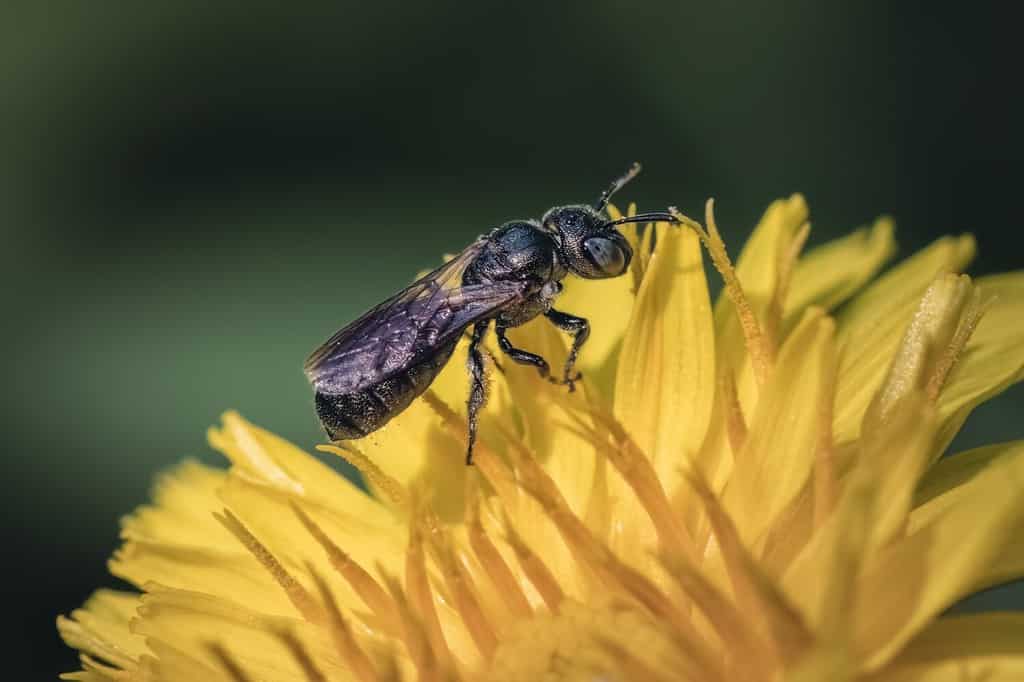
Amazingly, around 15% of crops rely on native bees, like carpenter bees, for pollination.
©Victoria Virgona/Shutterstock.com
The Ceratina bee genus, also known as small carpenter bees, differs significantly from the more commonly known carpenter bees, despite sharing a similar name.
With over 360 species, these cosmopolitan bees have black coloration with bluish-green or blue highlights and occasional yellowish-white markings on their face, thorax, and legs. Although small, measuring no more than 3/8 inch long, small carpenter bees play an essential role in pollinating various flowering plants found in gardens, natural areas, and farms.
Amazingly, around 15% of crops rely on native bees, like carpenter bees, for pollination.
Unlike other bees, however, small carpenter bees are solitary insects, with each female creating a nest without assistance from other bees. Small carpenter bees in Texas typically nest in hollow twigs or twigs with a soft pith, such as raspberry, elderberry, teasel, or brambles, or in old wood.
They create individual nest cells in each burrow, providing them with pollen and nectar. Interestingly, different species of Ceratina bees may nest in the same location.
Small carpenter bees have a polylectic nature, which means they visit various flowers from different plant groups to collect pollen. They are also generalists when it comes to gathering nectar.
Although they are capable of stinging, it is a rare occurrence, and only female small carpenter bees have stingers. Additionally, it is important to note that while small carpenter bees may sting if threatened, they are not usually aggressive toward people and will generally try to fly away if approached.
You may feel a sharp pain and a burning sensation at the site and surrounding area if stung by a small carpenter bee. Since these bees do not lose their stinger, there is no need to remove it from your skin. According to the Schmidt insect sting pain index, small carpenter bees fall into the lowest category, with a score of 1.
5. Pure Green Sweat Bee (Augochlora pura)
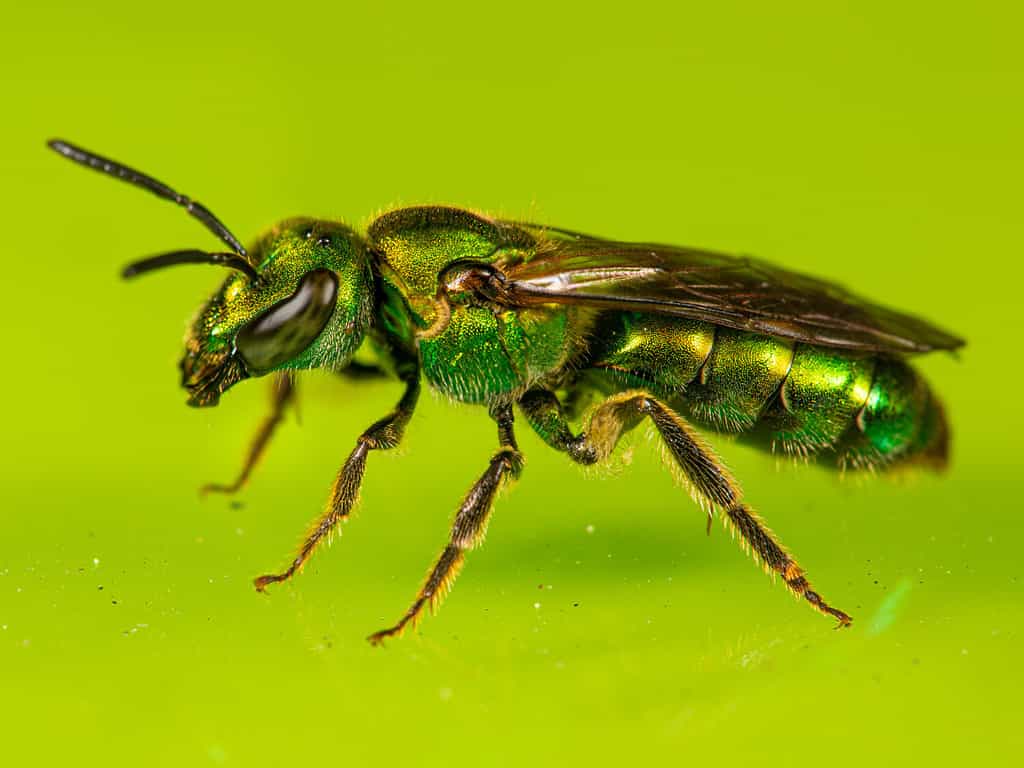
Pure green sweat bees are active from February to November, but their peak season is between April and October.
©Justin Starr Photography/Shutterstock.com
The pure green sweat bee is a species of sweat bee found in Texas, known for its remarkable appearance. These bees are brightly colored, with shiny bodies ranging from gold to green to blue, complemented by large black eyes and two dark wings. These bees are relatively small, measuring an average of 0.31 inches in length. While females have 12 antennae segments, males have 13.
Pure green sweat bees are active from February to November, but their peak season is between April and October. They typically build their nests in rotting wood in forests and wood piles found in suburban areas. Pure green sweat bees are usually found near their nests, but they may also venture into nearby brush and pastures.
Research indicates that these sweat bees account for approximately 91% of bees collected in bottomland hardwood forests in the southeastern United States.
Pure green sweat bees are primarily nectar feeders. They enjoy many types of flowers. They are also attracted to human sweat, hence their name, but are not aggressive towards people. While they may sting if startled, their stings are typically mild and fall into the lowest category on the Schmidt insect sting pain index, with a score of 1.
Symptoms of a sting may include pain, itching, redness, or swelling. However, it is worth noting that although their stings are typically mild, some individuals may experience an allergic reaction to bee stings. In rare cases, this can lead to a severe allergic reaction called anaphylaxis, which can be life-threatening.
4. Sonoran Bumble Bee (Bombus sonorus)

Sonoran bumble bees primarily feed on flower nectar and prefer temperate climates.
©Stanley Ford/Shutterstock.com
This bumble bee inhabits various areas in the southwest region of Texas, displaying vibrant colors and a notable size. These bees have a worker class ranging from 3/4 to 1 1/2 inches in length, with the queen being larger. Their head is predominantly black, complemented by bright yellow fur on the back and front of the thorax. A black band of fur breaks the yellow fur between their wings.
The Sonoran bumble bee’s colony starts when a solitary queen establishes a nest by herself and strives to gather pollen and nectar to raise her first offspring. As soon as the first group of offspring matures, they will take over the foraging and colony care, allowing the queen to focus on egg production.
Sonoran bumble bees primarily feed on flower nectar and prefer temperate climates. These ground-nesting bees nest in roof eaves or gables within insulation materials.
Unfortunately, the Sonoran bumble bee is Vulnerable on the IUCN list due to a significant decline in population due to habitat loss and pesticide use.
Despite being non-aggressive, their stings can be painful and pose a risk to people with allergies. Male bees are incapable of stinging, while females only do so when threatened. The sting typically causes redness, swelling, and itching in the affected area. In some cases, the swelling can be more prominent, particularly in areas with looser skin, such as the eyelids.
The Schmidt insect sting pain index rates these bumble bees with a score of 2, indicating that their sting is slightly more painful than that of smaller bees, like the small carpenter bee.
3. Digger Bee (Anthophorini)
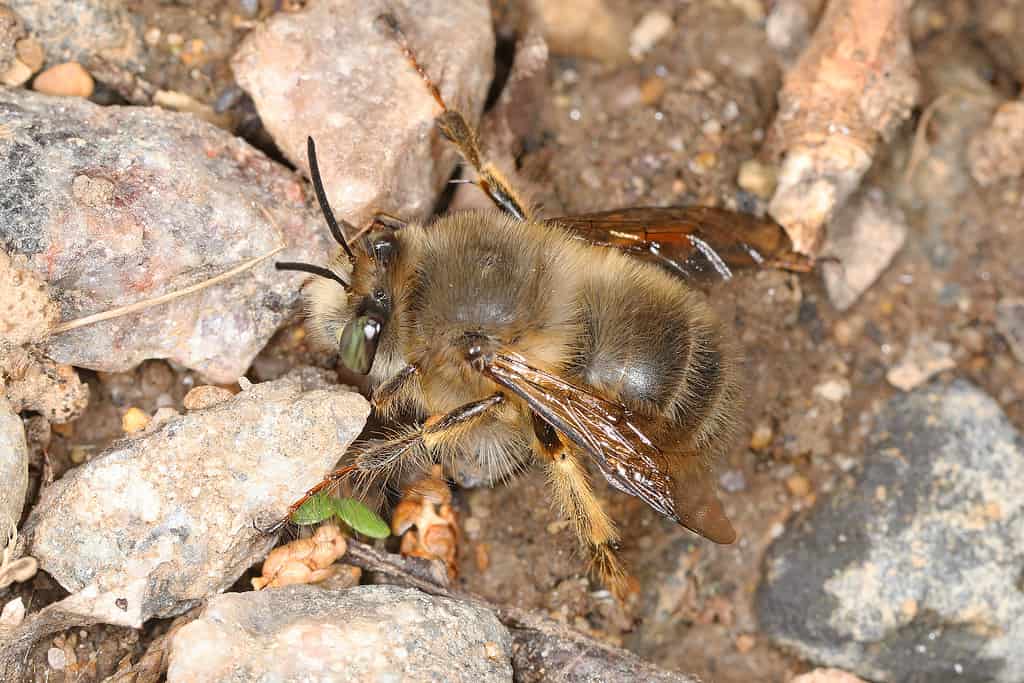
Unlike honeybees, digger
bees live
a solitary lifestyle, with each bee having its unique entrance to a private chamber.
©Judy Gallagher / Flickr – License
The Anthophorini, commonly known as digger bees, are a large tribe found in Texas and worldwide with an estimated 400 species.
Digger bees are intriguing creatures with distinctive appearance. These bees have black and yellow stripes that are more prominent than honeybees but not as bright as bumblebees. Typically, digger bees measure between 1/4 and 1/2 inch in length. They are in areas with sparse grass, such as dry or shady spots. Fortunately, these bees do not harm the turf, and some species even leave soil piles outside their holes.
Unlike honeybees, digger bees live a solitary lifestyle, with each bee having its unique entrance to a private chamber. The female adult digger bee spends most of its life underground, constructing a nest about 6 inches deep and creating a chamber filled with pollen and nectar to feed the larvae.
These bees are only present for a few weeks in the early spring and summer, but they play an essential role as pollinators for various plants. Digger bees rely on flower nectar for their diet and prefer warmer climates.
Unlike wasps or yellow jackets, digger bees are not aggressive and generally do not sting unless they feel threatened. However, their sting is potent enough to cause severe allergic reactions in some individuals, so it is always advisable to exercise caution around them and all species of stinging insects.
Although their sting may cause some discomfort, it is usually not severe enough to require medical attention. The Schmidt insect sting pain index rates these digger bees with a score of 2.
2. Western Honey Bee (Apis mellifera)
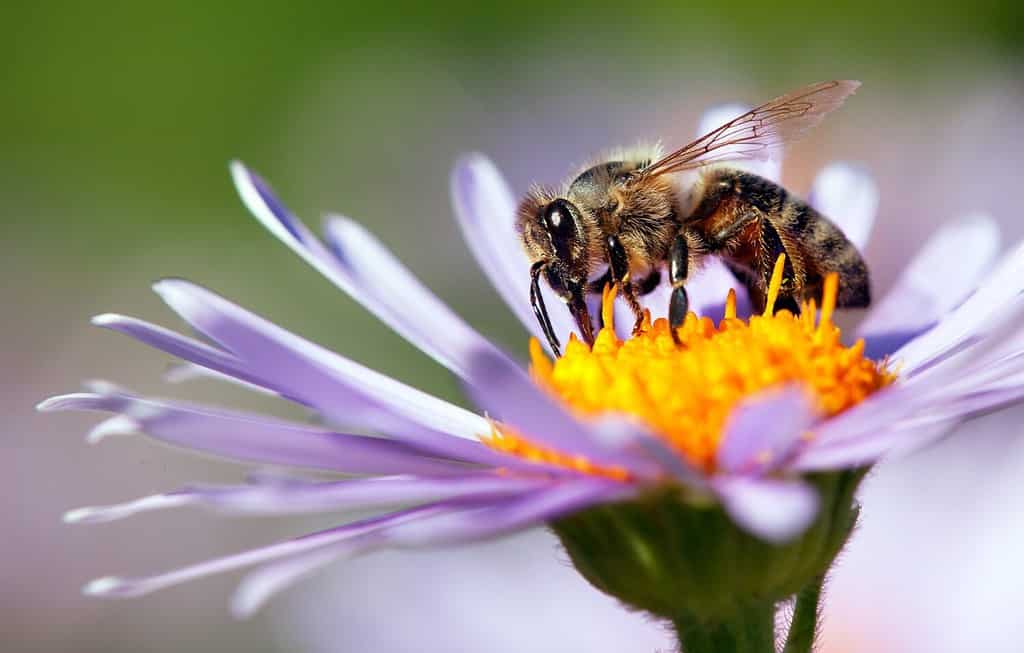
Honeybees possess impressive capabilities, such as the ability to fly at a maximum speed of 15 miles per hour.
©Daniel Prudek/Shutterstock.com
The western honey bee is a prevalent bee species in San Antonio, Texas. A single colony of these bees can range from 30,000 to 80,000 members, including drones, workers, and a queen. The queen has the impressive ability to lay around 2,000 eggs every day.
As the leading pollinator species for crops worldwide, Apis mellifera is highly efficient in its role. These bees typically have a brown color with faint yellow and brown bands on their abdomens. They have fine hairs on their heads, thoraxes, abdomens, legs, and surrounding their eyes.
Their diet consists of pollen and nectar gathered from flowers, as well as honey. Western honey bees prefer natural habitats such as gardens, forests, fruit groves, and fields. These bees were among the initial insects to be tamed by humans. Beekeepers continue to manage them for honey production and pollination services. With human support, these bees have flourished on all continents except Antarctica.
Honeybees possess impressive capabilities, such as the ability to fly at a maximum speed of 15 miles per hour. However, despite their incredible work ethic, a single honey bee worker can only produce an average of 1/12 of a teaspoon’s worth of honey throughout her lifetime. It’s truly remarkable to think that it takes approximately 2 million visits to flowers for honey bees to create a pound of honey.
The western honey bee is also known for its signature waggle dance, a unique behavior used by worker bees to communicate the direction and distance of nectar or pollen sources to other members of the hive. The dance involves a figure-eight pattern with the bee waggling its abdomen and making buzzing sounds to indicate the direction and distance of the food source.
It is crucial to recognize that individuals can have different reactions to their venom. A typical response may involve redness or swelling at the site of the sting, accompanied by warmth or itchiness.
In some cases, the swelling can be significant. The arm can swell up to the elbow if stung on the finger. These bees have a level of 2 on the Schmidt insect sting pain index.
1. Africanized Honey Bee (Apis mellifera scutellata)
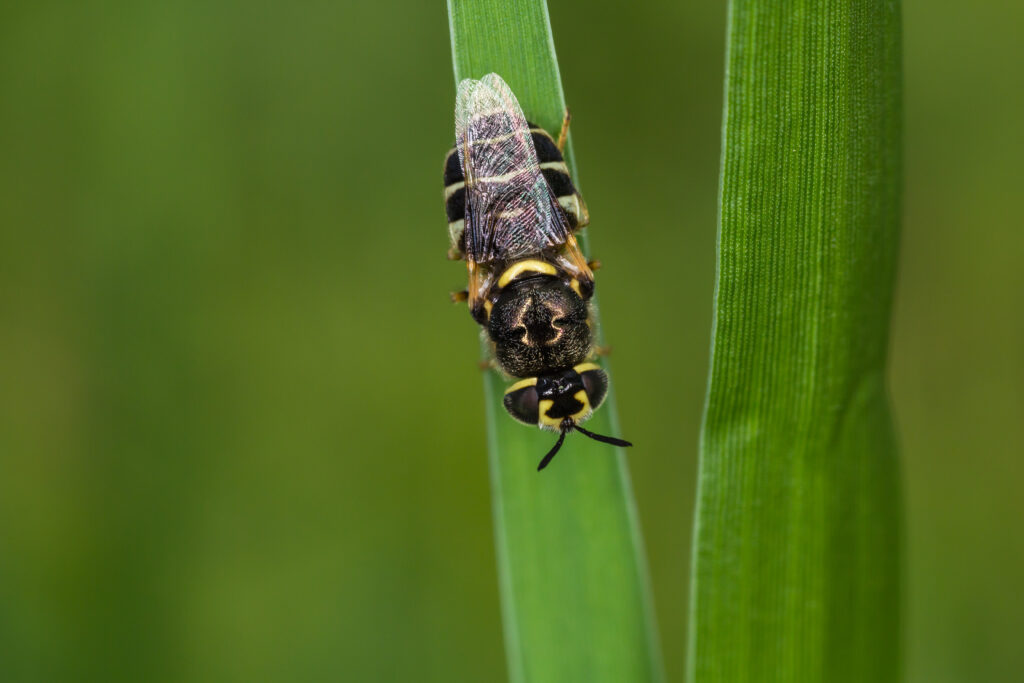
These bees are called killer bees and are invasive insects.
©aeiddam0853578919/Shutterstock.com
Texas is home to a notorious bee species that demands caution – the Africanized honey bee. They are also known as the “killer bee.” The presence of these bees is in 163 out of the 254 counties in Texas.
The Africanized honey bee shares a striking resemblance to domestic honey bees. The only noticeable difference is their slightly smaller size, which can be measured by body length. Their appearance features a golden yellow color with dark bands of brown. They range in size from .04 to 1 inch, depending on their specific role within the colony.
As pollinators, Africanized honey bees are highly effective and feed on nectar and pollen from a variety of flowering plants. They nest in voids, such as hollow trees, stumps, and building eaves.
Unfortunately, their aggressive nature and tendency to swarm make them dangerous to both animals and humans. This is especially so for those with allergic reactions to bee venom. Swarms of Africanized honey bees have been known to kill pets, livestock, and even humans. It is crucial to avoid them at all costs.
Although the Schmidt insect sting pain index does not provide a specific rating for Africanized bees, domestic honey bees, which the Africanized honey bee is a subspecies of, have a rating of 2 on the pain scale. Therefore, the pain from an Africanized bee sting could also be rated a rank of 2, or perhaps even 3, on the scale.
The photo featured at the top of this post is © HWall/Shutterstock.com
Thank you for reading! Have some feedback for us? Contact the AZ Animals editorial team.






